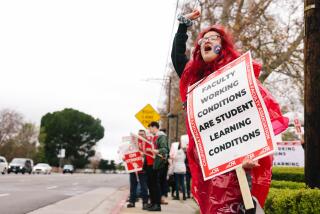University Faculties Being Taught to Teach : Higher education: Students see special training centers as reassuring news about the quality of instruction they are receiving while tuition continues to spiral.
- Share via
NORTHAMPTON, Mass. — It’s a cold and gloomy Friday morning near the end of the semester, but the students in one Smith College mathematics class sit spellbound.
They’re deep into a calculus equation meant to figure out the speed with which a vat of grape juice ferments into wine.
“Here the problems are complex, they’re messy, but they’re interesting,” said teacher Jim Callahan, part of a group devising new ways to teach calculus. “It draws the students in.”
Smith and four other colleges in western Massachusetts have begun a three-year, $300,000 campaign that tackles something higher education is often accused of overlooking: teaching teachers to teach.
The others are the University of Massachusetts, Mt. Holyoke, Amherst and Hampshire.
Kirsten Tambo, a Smith sophomore, said the effort makes a difference.
“I took calculus in high school and it was just a bunch of numbers on the board. This is more like real life,” she said.
A recent report by the Wingspread Group on Higher Education said colleges and universities put teaching second to research.
“Too much of education at every level seems to be organized for the convenience of educators and the institutions’ interests, procedures and prestige, and too little focused on the needs of students,” the commission said.
It was the latest in a series of similar pronouncements, and more universities are taking note.
“Teaching is a difficult art,” said Edward Foote, University of Miami’s president. “Some people are born to it. Some have to learn it.”
His university is one of several that have opened centers in which teachers can volunteer to be videotaped and critiqued.
Similar centers are run by Stanford University, the University of Georgia, Southwest Texas State, the University of Washington, the University of Massachusetts and Carleton College in Minnesota.
Students see the centers as reassuring news about the quality of education they receive while tuition spirals.
“When a teacher has difficulty communicating, you’re wasting your money and your time,” said Tchiyuka Cornelius, president of the U.S. Student Assn.
Some faculty say they’re taking too much of the blame. They say research enhances, and does not impede, their teaching.
“There is a notion that people are good researchers and therefore not interested in undergraduate teaching,” said Robert Hallock, chairman of physics and astronomy at the University of Massachusetts.
“In fact, the vitality they gain from doing research at the frontier keeps them enthusiastic, and when they get into the classroom they communicate that enthusiasm to undergraduates.”
Ernst Benjamin, general secretary of the 42,000-member American Assn. of University Professors, said the problem isn’t with the quality of teaching, but with other obstacles to learning.
“The major problems have to do with issues like the students being part-time, the faculty being part-time, the substitution of two-year for four-year education and large class sizes,” Benjamin said. “I don’t see training faculty to teach as any panacea.”
He said the debate about getting faculty to teach better is really about getting faculty to teach more.
Donald Wulff, assistant director of the Center for Instructional Development and Research at the University of Washington and president of a national faculty teacher training network, said the problem is “finding a workable balance between the teaching and research.”
More to Read
Sign up for Essential California
The most important California stories and recommendations in your inbox every morning.
You may occasionally receive promotional content from the Los Angeles Times.













